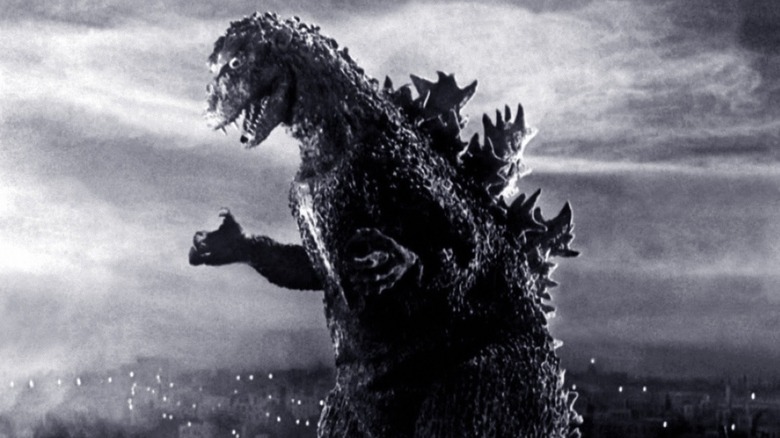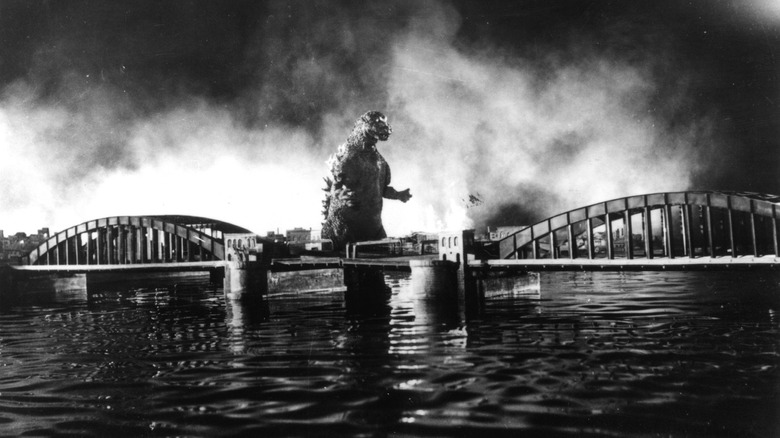Godzilla's Original Costume Was One Of The Most Punishing Weight Loss Systems Of All Time
There are few monster movies that can claim to have as much respect in cinema history, as well as just sheer scope of influence, as 1954's "Godzilla." Also known as "Gojira" in its native Japan, the heralded classic of the kaiju genre remains a haunting dissection of the atrocities of World War II through the lens of a nation contending with the horrors they faced, namely the atomic bomb. It's also, not for nothing, one heck of a showcase for old-school practical creature effects. The now-iconic titular monster was brought to life using a practical suit worn by Haruo Nakajima. A legend was born of that performance, but he paid the price during filming.
In the 2017 book "Godzilla on My Mind" by William M. Tsutsui, it's explained that the costume used in "Godzilla" was created using "a framework of bamboo stakes and wire, with thick overlays of latex and plentiful padding of urethane foam." The first costume weighed more than 200 pounds and simply couldn't be used. The second one was lighter and slightly more flexible, but still proved challenging for Nakajima to manage. The man had to sweat and suffer a whole lot to make this bit of movie magic happen. As Tsutsui explains in the book:
"Under hot stage lights, barely able to breathe or see, Nakajima could spend no more than a few minutes at a time sealed within the costume. Technicians would regularly pour a cup of Nakajima's sweat out of the suit between takes and the actor reported losing 20 pounds in weight over the course of the shoot."
Despite literally being accused of being terrorists, the special effects artist on "Godzilla" managed to create something masterful alongside Haruo. More than just a man in a suit, there is a real performance underneath all of that bamboo and wire — one that the actor in question managed to deliver under grueling circumstances.
Haruo Nakajima suffered to make history with Godzilla
Nakajima, for his part, gained a bit of cinematic immortality for his suffering. Prior to his work in "Godzilla," he had been a journeyman actor taking on minor roles, in addition to being a stunt performer. As Tsutsui's book explains, he was recruited for the role because he was in good shape physically, and also had a "dogged determination." In preparation for the role, Nakajima watched movies like the original 1933 classic "King Kong" and "Mighty Joe Young." He also visited Tokyo's Ueno Zoo to observe bears and other large animals. He could have treated it as a silly job playing a monster in a suit. He, instead, took it seriously and the film's lasting legacy speaks for itself.
"Godzilla" was a massive success in its day and spawned a series of sequels. Nakajima would return as Godzilla in 1955's "Godzilla Raids Again," with other actors subsequently donning the suit for the rest of the classic Toho era of the franchise. Eventually, CGI would replace the man in a suit, but there is still something to the tangibility of those early movies that makes them feel real, despite also being very low-tech by today's standards.
Without Nakajima's (unintentional) "weight loss program," we might not be living in a world where, 70 years later, this franchise is still going strong. From the success of last year's Oscar-winning "Godzilla Minus One" to this year's "Godzilla x Kong: The New Empire," the King of the Monsters is arguably more popular than he's ever been. Nakajima deserves a great deal of credit for everything that has come since he first put on that cumbersome suit all those years ago.

